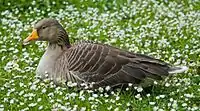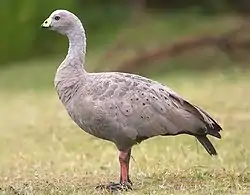Goose
A goose (plural geese) is a bird of any of several waterfowl species in the family Anatidae. This group comprises the genera Anser (the grey geese and white geese) and Branta (the black geese). Some other birds, mostly related to the shelducks, have "goose" as part of their names. More distantly related members of the family Anatidae are swans, most of which are larger than true geese, and ducks, which are smaller.
.jpg.webp)
The term "goose" is more properly used for a female bird, while "gander" refers specifically to a male one. Young birds before fledging are called goslings.[1] The collective noun for a group of geese on the ground is a gaggle; when in flight, they are called a skein, a team, or a wedge; when flying close together, they are called a plump.[2]
Etymology
The word "goose" is a direct descendant of Proto-Indo-European root, ghans-. In Germanic languages, the root gave Old English gōs with the plural gēs and gandres (becoming Modern English goose, geese, gander, and gosling, respectively), Frisian goes, gies and guoske, New High German Gans, Gänse, and Ganter, and Old Norse gās.
This term also gave Lithuanian: žąsìs, Irish: gé (goose, from Old Irish géiss), Latin: anser, Spanish: ganso, Ancient Greek: χήν (khēn), Dutch: gans, Albanian: gatë (heron), Sanskrit haṃsa and haṃsī ("gander" and "goose", also the words for male and female swans), Finnish: hanhi, Avestan zāō, Polish: gęś, Romanian: gâscă / gânsac, Ukrainian: гуска / гусак (huska / husak), Russian: гусыня / гусь (gusyna / gus), Czech: husa, and Persian: غاز (ghāz).[1][3]
True geese and their relatives

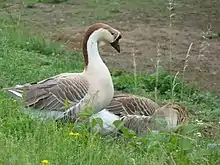
The two living genera of true geese are: Anser, grey geese and white geese, such as the greylag goose and snow goose and Branta, black geese, such as the Canada goose.
Two genera of geese are only tentatively placed in the Anserinae; they may belong to the shelducks or form a subfamily on their own: Cereopsis, the Cape Barren goose, and Cnemiornis, the prehistoric New Zealand goose. Either these or, more probably, the goose-like coscoroba swan is the closest living relative of the true geese.
Fossils of true geese are hard to assign to genus; all that can be said is that their fossil record, particularly in North America, is dense and comprehensively documents many different species of true geese that have been around since about 10 million years ago in the Miocene. The aptly named Anser atavus (meaning "progenitor goose") from some 12 million years ago had even more plesiomorphies in common with swans. In addition, some goose-like birds are known from subfossil remains found on the Hawaiian Islands.
Geese are monogamous, living in permanent pairs throughout the year; however, unlike most other permanently monogamous animals, they are territorial only during the short nesting season. Paired geese are more dominant and feed more, two factors that result in more young.[4][5]
Geese honk while in flight to encourage other members of the flock to maintain a 'v-formation' and to help communicate with one another.[6]
History of geese
Geese fossils have been found ranging from 10 to 12 million years ago. Fossils found in the Gagarno region of central Italy suggest the existence of a pre-historic relative of the goose, that stood one and a half metres tall. The evidence suggests the bird was flightless unlike modern geese.[7]
Other birds called "geese"
Some mainly Southern Hemisphere birds are called "geese", most of which belong to the shelduck subfamily Tadorninae. These are:
- The Orinoco goose (Neochen jubata)
- The Egyptian goose (Alopochen aegyptiaca)
- The South American sheldgeese in the genus Chloephaga
- The prehistoric Malagasy sheldgoose (Centrornis majori)
Others:
- The spur-winged goose (Plectropterus gambensis) is most closely related to the shelducks, but distinct enough to warrant its own subfamily, the Plectropterinae.
- The blue-winged goose (Cyanochen cyanopterus) and the Cape Barren goose (Cereopsis novaehollandiae) have disputed affinities. They belong to separate ancient lineages that may ally either to the Tadorninae, the Anserinae, or closer to the dabbling ducks (Anatinae).
- The three species of small waterfowl in the genus Nettapus named "pygmy geese"; they seem to represent another ancient lineage, with possible affinities to the Cape Barren goose or the spur-winged goose.
- The maned goose, also known as the maned duck or Australian wood duck (Chenonetta jubata)
- A genus of prehistorically extinct seaducks, Chendytes, is sometimes called the "diving-geese" due to their large size.[8]
- The magpie goose (Anseranas semipalmata) is the only living species in the family Anseranatidae.
- The northern gannet (Morus bassanus), a seabird, is also known as the "solan goose", although it is unrelated to the true geese, or any other Anseriformes for that matter.
In popular culture
Well-known sayings about geese include:
- To "have a gander" is to examine something in detail.
- "What's sauce for the goose is sauce for the gander" or "What's good for the goose is good for the gander" means that what is an appropriate treatment for one person is equally appropriate for someone else.
- Saying that someone's "goose is cooked" means that they have suffered, or are about to suffer, a terrible setback or misfortune.
- The common phrase "silly goose" is used when referring to someone who is acting particularly silly.
- "Killing the goose that lays the golden eggs", derived from an old fable, is a saying referring to any greed-motivated, unprofitable action that destroys or otherwise renders useless a favourable situation.
- "A wild goose chase" is a useless, futile waste of time and effort.
- There is a legendary old woman called Mother Goose who wrote nursery rhymes for children.
- A raised, rounded area of swelling (typically a hematoma) caused by an impact injury is sometimes metaphorically called a "goose egg", especially if it occurs on the head.[9]
"Gray Goose Laws" in Iceland
The oldest collection of Medieval Icelandic laws is known as "Grágás"; i.e., the Gray Goose Laws.
Various etymologies were offered for that name:
Gallery
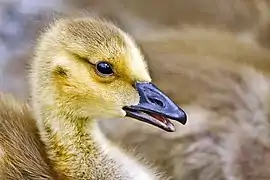 Canada goose gosling
Canada goose gosling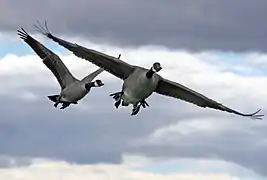 Canada geese in flight, Great Meadows Wildlife Sanctuary
Canada geese in flight, Great Meadows Wildlife Sanctuary
See also
- Angel wing, a disease common in geese
- Domestic goose, which includes cooking and folklore
- Flying geese paradigm
- List of Anseriformes by population
- List of goose breeds
- Roast goose
- Waterfowl
- Wildfowl
- Untitled Goose Game, a video game centering around a goose that takes place in a middle-class village in England.
References
- Partridge, Eric (1983). Origins: a Short Etymological Dictionary of Modern English. New York: Greenwich House. pp. 245–246. ISBN 0-517-414252.
- "AskOxford: G". Collective Terms for Groups of Animals. Oxford, United Kingdom: Oxford University Press. Archived from the original on 20 October 2008. Retrieved 19 September 2011.
- Crystal, David (1998). The Cambridge Encyclopedia of Language. ISBN 0-521-55967-7.
- Lamprecht, Jürg (1987). "Female reproductive strategies in bar-headed geese (Anser indicus): Why are geese monogamous?". Behavioral Ecology and Sociobiology. Springer. 21 (5): 297–305. doi:10.1007/BF00299967. S2CID 34973918.
- "Canada Goose | National Geographic". Animals. 2011-05-10. Retrieved 2020-11-21.
- "Interesting facts about geese | Just Fun Facts". justfunfacts.com. Retrieved 2020-11-21.
- "Fossils from ancient extinct giant flightless goose suggests it was a fighter". phys.org. Retrieved 2020-11-21.
- Howard, Hildegarde (1955). "New Records and a New Species of Chendytes, an Extinct Genus of Diving Geese". The Condor. 57 (3): 135–143. doi:10.2307/1364861. JSTOR 1364861.
- Roland, James. "What’s Causing This Bump on My Forehead, and Should I Be Concerned?" HealthLine, 2 Aug 2018. Retrieved 24 Mar 2020. https://www.healthline.com/health/bump-on-forehead
- Boulhosa, Patricia Press. “The Law of Óláfr inn Helgi.” In Icelanders and the Kings of Norway: Mediaeval Sagas and Legal Texts. Leiden, Netherlands: Brill, 2005.
- Byock, Jesse L., Medieval Iceland: Society, Sagas, and Power, Berkeley: University of California, 1990
- Byock, Jesse L. "Grágás: The 'Grey Goose' Law in Viking Age Iceland London: Penguin, 2001.
Further reading
- Carboneras, Carles (1992). "Family Anatidae (Ducks, Geese and Swans)". In del Hoyo, Josep; Elliott, Andrew; Sargatal, Jordi (eds.). Handbook of Birds of the World. Volume 1: Ostrich to Ducks. Barcelona: Lynx Edicions. pp. 536–629. ISBN 84-87334-10-5.
- Terres, John K.; National Audubon Society (1991) [1980]. The Audubon Society Encyclopedia of North American Birds. New York: Wings Books. ISBN 0-517-03288-0.
External links
| Wikimedia Commons has media related to Geese. |
| Wikiquote has quotations related to: Geese |
| Look up goose in Wiktionary, the free dictionary. |
- Anatidae media on the Internet Bird Collection
